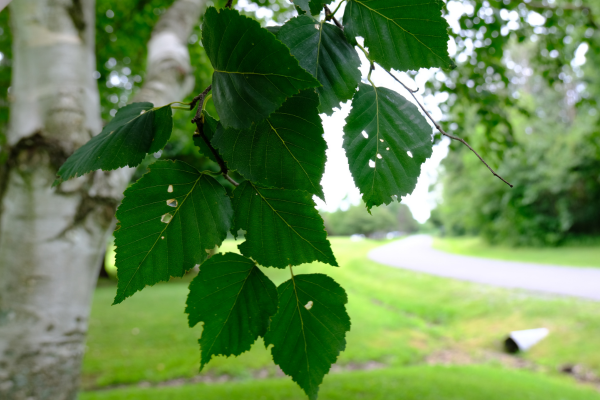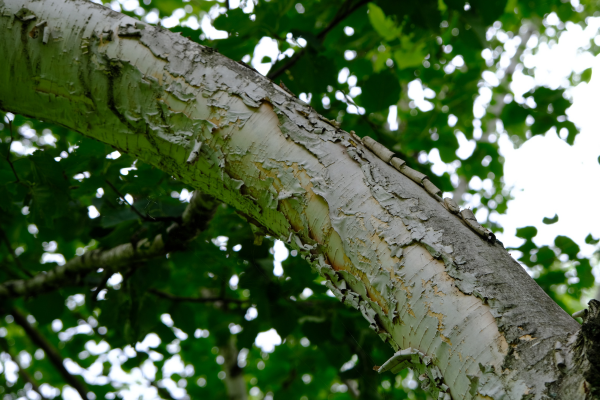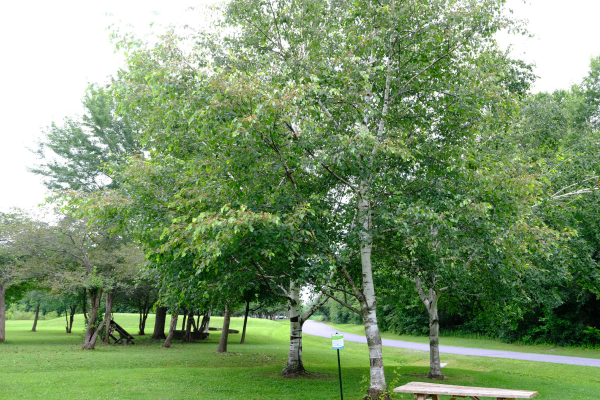Also known as paper birch or canoe birch.
Scientific name: Betula papyrifera
Betula = Latin word for birch, from the Gaulish word betu (bitumen) because the Gauls extracted tar from birches.
papyrifera = "paper-bearing", reffering to the thin, white paper-like bark that peels from the tree.
The white birch, also known as the paper birch, is found all throughout Ontario except along the shoreline of Hudson Bay. This tree is characterized by its large, peeling sheets of thin, white bark on mature specimens. The buds, leaves and seeds of the tree are important food sources for many birds and mammals. Bird species such as woodpeckers and sapsuckers will make their nests within the cavities of white birch. The papery bark of the tree takes a very long time to decompose, so one will often see long pieces of this bark on top of a nearly decomposed log!
White birch can grow in a variety of moisture levels and soil types. However, it is shade intolerant and needs full sun to thrive. The tree is often used in landscaping due to its ability to grow almost anywhere when given enough light. This tree is fast growing, though short-lived, with an average lifespan of 80 years. Be sure not to peel off the bark of white birch as when done too much, it can seriously harm or even kill the tree. As with many birch species, the bronze birch borer poses a threat. This small boring beetle lays its eggs on the bark. When hatched, the larvae will bore their way into the tree to feed on its phloem (the structure of the tree responsible for nutrient circulation).
The wood from white birch has many commercial uses. This includes being used for pulpwood, specialized lumber, veneer, popsicle sticks, furniture, and cabinetry. Syrup can also be made from their sap. The sap contains a lower sugar content than that of maple trees, meaning it does need to be boiled for much longer to make syrup. Indigenous people used the trees pliable bark to build canoes, baskets, and cradles. It was also used to weatherproof their wigwams. The leaves were also used to make soap and shampoo and its wood to make toboggans, utensils, and dishes. To the process of wood carving, see the video "How to carve a wooden spoon from birch wood"
Sources:
OMNR. 2022. Ontario Ministry of Natural Resources: Ontario Tree Atlas. [online] Available: https://www.ontario.ca/page/white-birch
OMNR. Ontario's Tree Atlas. [online] Available: https://pecmastergardeners.ca/wp-content/uploads/2020/07/Ontarios-Tree-Atlas.pdf
Ontario Wildlife Federation. 2022. Plant & Habitat Fact Sheets - Paper Birch. [online] Available: https://www.ontwf.org/wp-content/uploads/2016/07/PaperBirch.pdf
Sierra Club BC. Paper Birch. [online] Available: https://sierraclub.bc.ca/paper-birch/
University of Guelph. Guelph Arboretum: Paper Birch - Betula papyrifera. [online] Available: https://arboretum.uoguelph.ca/thingstosee/trees/paperbirch
%20938-3611%20info%40rrca_on_ca%20rrca_on_catrees%20(400%20%C3%97%20200%20px)%20(1).jpg)


.jpg) White birch forest at RRCA's
White birch forest at RRCA's  The leaves of white birch are ovate with serrations that run along its sides. The leaves turn a bright yellow colour in the fall.
The leaves of white birch are ovate with serrations that run along its sides. The leaves turn a bright yellow colour in the fall. White birch is often planted as an ornamental tree due to their attractive white bark. This wood is excellent for starting a campfire and can burn at high temperatures even when the wood is wet.
White birch is often planted as an ornamental tree due to their attractive white bark. This wood is excellent for starting a campfire and can burn at high temperatures even when the wood is wet.  The canopy of white birch can be irregular in shape. The branches of mature trees droop as they grow larger.
The canopy of white birch can be irregular in shape. The branches of mature trees droop as they grow larger.